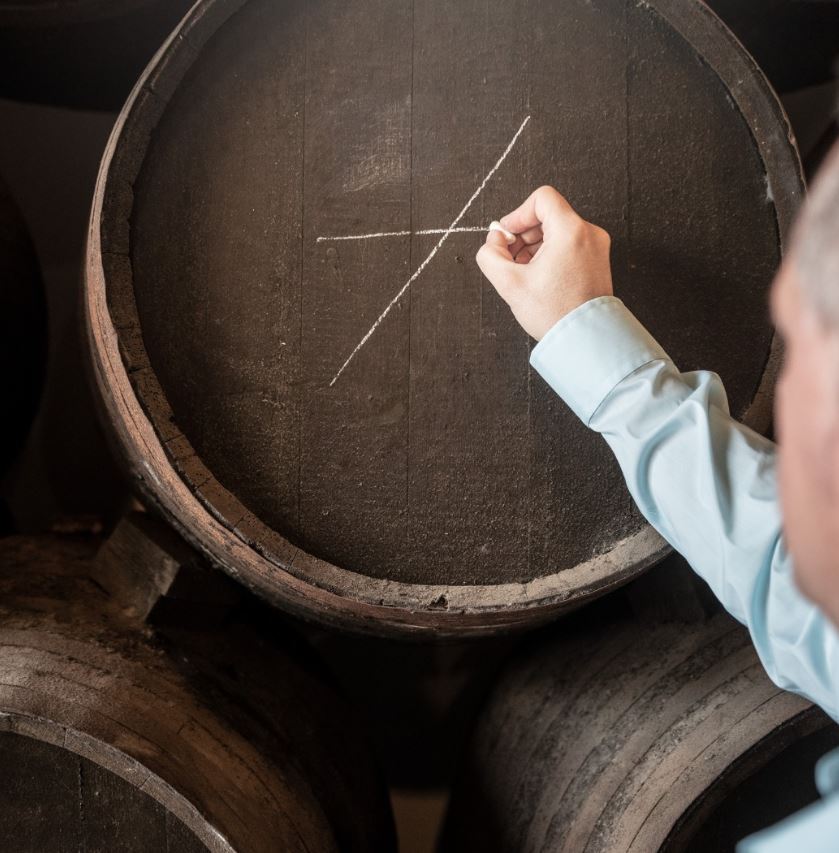
ルスタウのシェリーが辿る道のりを記す象徴の解明
ヘレスの歴史あるボデガ(酒蔵)では何世紀もの伝統と丹念な職人技が交わり、樽がその物語を語り継いでいます。神秘的なチョークの印が刻まれた一つ一つの樽は、「カパタス」と呼ばれる醸造責任者の手によってそれぞれの樽で育まれたシェリーの過去、現在、そして未来の可能性が記されています。醸造責任者はこのチョークでの印によって熟成過程を見守り、導き、発酵から最終段階に至るまでのシェリーの深みある重厚な物語を紡ぎ出すのです。
シェリー樽の技法:伝統を育む容器の製作
「ボタ」として知られるシェリー樽は、ブドウの品質と同様に、シェリーの風味と個性に不可欠な存在です。主にアメリカンオークで作られるこれらの樽は何十年もの使用に耐えるよう作られており、ルスタウのボデガには100年以上の歴史を持つ樽も存在します。他の蒸留酒に使用される樽とは異なり、シェリー樽は頻繁に交換されることはありません。その代わりに時間をかけて丁寧に手入れされ熟成を重ねることによって、それぞれのシェリーに歴史を刻み込む生きた器となっているのです。その技は、木材とシェリーの微妙なバランスを理解する熟練の樽職人によって代々受け継がれ、樽がソレラシステム—若いワインと古い原酒をブレンドしてシェリー特有の複雑さと深みを生み出す熟成方法—を支え続けています。
チョークマークの解読:醸造責任者の暗号
シェリー樽のチョークマークは19世紀初頭からヘレスのシェリー造りにおける伝統の一部となり、醸造責任者がベースとなるワイン、そして熟成過程のシェリーを分類し、評価し、管理するための独特な“言語”として発展してきました。発酵後、カパタスによってそれぞれの樽をチェックし、特定のタイプのシェリーとしての可能性に基づいて分類されます。
チョークマークの意味:シェリースタイルの“言語”
ルスタウのボデガでは、樽は単なる器以上の存在—それは樽の中のシェリーの成長を見守る記録者なのです。樽の前面に記されたチョークマークは、それぞれの樽のシェリーの進化する個性を明らかにし、そのタイプと将来の可能性について重要な選択をします。これらのマークは、「カパタス」である醸造責任者が時間の経過とともにシェリーの変化を観察し、導くためのコミュニケーションツールとして機能します。
フィノ、アモンティリャード、パロコルタド、オロロソ、モスカテル、ペドロヒメネスといった各タイプのシェリーにはそれぞれ独自の象徴的なマークがあり、ボデガの熟成過程の管理に役立てられています。

* フィノ、マンサニーリャ:縦線に斜めの線が交わるマーク。これは酵母の膜(フロール)の下で生物学的に熟成され、ミネラリーでナッツのようなニュアンスを持つクリーンでフレッシュな辛口シェリーを示します。(ルスタウはこの印を樽に使用していませんが、これはシェリー業界の標準的なマークです)

* アモンティリャード:頂点に円がついた様式化された「A」。これは最初はフロールの下で生物学的に熟成を始めたが、後に酸化熟成に移行することによって複雑でナッツのような芳醇な風味を持つシェリーを示します。

* パロコルタード:短い横線で切られた(コルタード)縦棒(パロ)。アモンティリャードの芳香的な繊細さとオロロソのボディを併せ持つ、稀少で卓越したワインを表します。

* オロロソ:単純な円または「O」。完全に酸化熟成を経たワインを示し、ドライフルーツやローストナッツの豊かで力強い風味が特徴です。

* モスカテル:甘さを示す記号を伴うことの多い様式化された「M」。モスカテル種のブドウから作られる香り高い自然な甘口ワインを示します。

* ペドロヒメネス(PX):「PX」の文字。天日干しにしたペドロヒメネス種のブドウから作られる、レーズンのような贅沢なデザートワインを示します。
ソレラシステムにおける樽の不可欠な役割
シェリーの熟成において、樽は単にシェリーを保管するだけでなく、その本質を形作ります。ルスタウのソレラシステム内の樽はそれぞれが語り部となり、そのマークがこの複雑な工程を通じて時を刻んだシェリーの旅を明らかにします。これらのチョークの印はカパタスとシェリーの間の静かに進化する対話を捉えながら、シェリー造りの技術と知識の架け橋となっています。
ソレラシステムは異なる熟成期間のシェリーを交わらせ、最終的にバランスの取れた複雑さを付与します。熟成した樽は穏やかな酸化を可能にし、シェリーの風味を豊かにする一方で、チョークマークは醸造責任者が伝統と革新のこの繊細なブレンドを指揮する際の指針となります。検査のたびにカパタスは分類を見直しそれぞれのシェリーがその最適な表現と一致することをより確実にします。
これらのマークは単なる表記以上のものです。それらは何世紀もの伝統を記憶しながら、ルスタウのシェリーがその独特の個性を維持することを保証する視覚的な“言語”なのです。 つまり、それぞれの樽の中には液体以上のものが宿っており、それらはヘレスの精神を育み、ルスタウのシェリーを定義する入念な管理と職人技を体現しているのです。
(English Below)
The Silent Language of Sherry: Decoding the Chalk Markings on Sherry Casks
Unveiling the Symbols that Chronicle the Journey of Lustau’s Sherry
In the storied bodegas of Jerez, where centuries-old traditions converge with careful craftsmanship, the casks tell a tale of patience, skill, and dedication. Adorned with mysterious chalk symbols, each barrel becomes a silent record of its contents’ journey—its past, present, and potential future—marked by the hands of the “capataz”, or cellar master. This ancient system of chalk markings allows the cellar masters to oversee and guide the aging process, creating a rich, layered story of sherry from fermentation to its final stages.
The Art of Sherry Cooperage: Crafting Vessels of Tradition
Sherry casks, known as "botas," are as integral to the flavor and character of sherry as the grapes themselves. These barrels, typically made from American oak, are crafted to withstand decades of use, with some barrels in Lustau's bodegas dating back over a century. Unlike barrels used for other spirits, sherry casks are not replaced frequently; instead, they are carefully maintained and seasoned over time, becoming living vessels that infuse each wine with its history. The art of cooperage is preserved by skilled artisans who understand the subtle balance between wood and wine, ensuring each cask continues to support the solera system—an aging process that blends younger wines with older reserves, creating sherry's unique complexity and depth.
Deciphering the Chalk Markings: A Cellar Master's Code
The chalk markings on sherry casks have been a part of Jerez’s winemaking tradition since the early 19th century, evolving into a specialized language used by cellar masters to classify, evaluate, and monitor their wines. After fermentation, each barrel is checked and classified by the capataz, who assigns it a category based on its potential as a specific type of sherry.
Decoding the Chalk Markings: The Language of Sherry Styles
In Lustau’s bodegas, each barrel is more than just a vessel—it’s a chronicle of the sherry it nurtures. The chalk markings scrawled on the front of each cask reveal the evolving identity of the wine inside, providing crucial insights into its type and future potential. These markings act as a shorthand communication tool for the “capataz,” or cellar master, to monitor and guide the wine’s transformation over time.
Each type of sherry—Fino, Amontillado, Palo Cortado, Oloroso, Moscatel, and Pedro Ximénez—has its own symbolic mark, serving as a quick reference for cellar management:
- Fino and Manzanilla: A vertical line crossed with a diagonal slash. This indicates a wine that will be aged biologically under flor resulting in a dry sherry, clean and fresh with minerally, nutty notes. (Lustau does not mark their barrels with this notation, though it is used by other bodegas.)
- Amontillado: A stylized “A” with a circle at its apex. This indicates a wine that began aging biologically under flor but transitioned to oxidative aging, creating a complex, nutty profile.
- Palo Cortado: A vertical line (palo) with a short cross mark added (cortado), signifying a rare and exceptional wine with the aromatic finesse of Amontillado and the body of Oloroso.
- Oloroso: A simple circle or "O," marking wines that age entirely through oxidation, resulting in rich, bold flavors of dried fruits and toasted nuts.
- Moscatel: A stylized "M," often accompanied by a symbol for sweetness, indicating a fragrant, naturally sweet wine derived from Moscatel grapes.
- Pedro Ximénez (PX): The letters "PX," identifying the luscious, raisin-like dessert wines made from sun-dried Pedro Ximénez grapes.
These markings provide a visual record of the wine’s journey through Lustau’s solera system. With each inspection, the capataz may refine the classification, ensuring the wine’s trajectory aligns with its optimal expression.
This system of markings bridges the art and science of sherry-making, preserving centuries of tradition while ensuring Lustau’s sherries maintain their distinctive character. Through this silent language, each cask becomes a storyteller, revealing the care and craftsmanship that define the wines of Jerez.
The Integral Role of Casks in the Solera System
In sherry production, barrels do more than just store wine—they shape its essence. The solera system allows wines of different ages to intermingle, imparting a balanced complexity to the final product. Seasoned casks allow for gentle oxidation, enriching the wine’s flavors, while the chalk markings guide cellar masters in orchestrating this intricate system of blending and aging. Each cask’s contents contribute to the solera, and each chalk mark serves as a vital cue for managing this dynamic process, ensuring consistency and quality across vintages.
Thus, these chalk symbols are more than mere notations. They represent a silent, evolving dialogue between the cellar master and the wine, capturing the artistry and meticulous care that define sherry’s unique character. Lustau's sherry casks, with their timeworn markings and carefully preserved histories, hold more than just wine—they carry the spirit and tradition of Jerez.
この生産者について詳しく知る

国際コンクール最多の受賞歴を誇るシェリー界の巨人
ルスタウ社は、1896年に一人のアルマセニスタによって設立されたスペイン屈指のシェリーメーカーです。1945年から自社ブランドのボトリングを開始し、1980年にはプレミアムシェリーの代名詞にもなっている「アルマセニスタ・シリーズ」を発表。現在ルスタウ社は、クオリティ・シェリーのベンチマークとして、最も信頼されるブランドの一つに数えられています。
2016 IWSC Best Sherry Producer
2017,2022 IWC Best Spanish Winemaker(醸造家 セルヒオ・マルティネス氏)
2017-2022, 2024 IWC Best Fortified Winemaker








